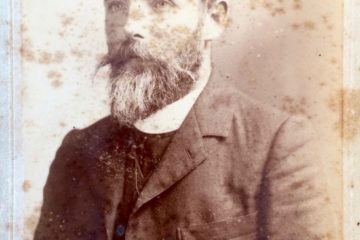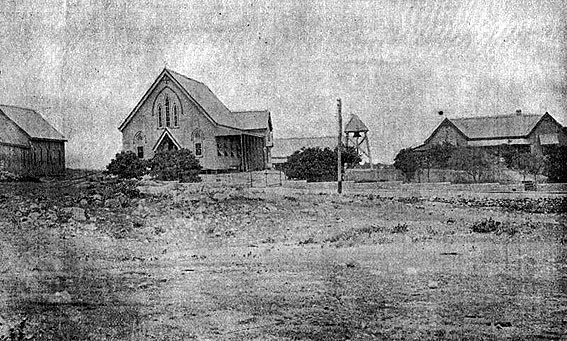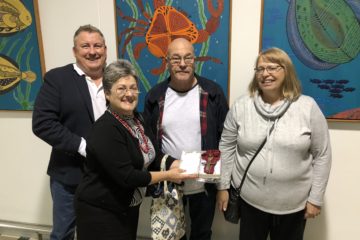Canon Jones Memorial Chapel
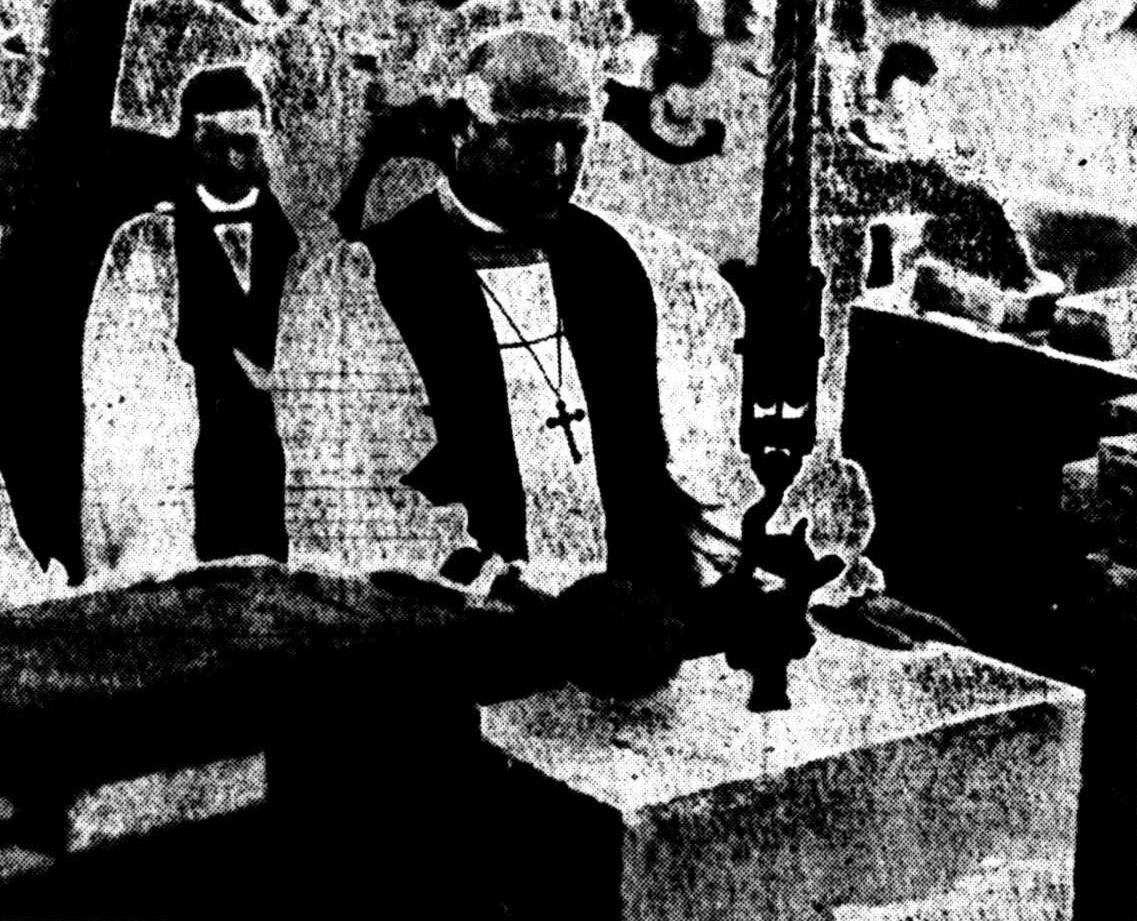
ABOVE: This image appeared in “The Brisbane Courier” of 2 August 1923 (pg8). The caption read: “The Archbishop of Brisbane (Dr. Gerald Sharp) laying the Foundation Stone of the Canon Jones Memorial Chapel at the Church of England Grammar School at East Brisbane yesterday afternoon. — Berry and Whalley photo”
CANON JONES MEMORIAL.
SCHOOL CHAPEL FOUNDATION STONE LAID.
CEREMONY AT EAST BRISBANE.
“THE object of the Grammar School is the training of character on the foundation of the Christian faith. That work Is doubly hard without a school chapel. This chapel will be the fortress of the boys’ religion, and the sanctuary of their spiritual life.” — The Headmaster (Rev W.P.F. Morris).
AN interesting ceremony which is likely to be of historical importance from an ecclesiastical standpoint was performed at East Brisbane yesterday afternoon, when His Grace the Archbishop of Brisbane (Dr. Sharp) [ Gerald Sharp ] laid the Foundation Stone of the Canon Jones Memorial Chapel at the Church of England Grammar School, Brisbane.
The Archbishop was attended by the Rev. W.H.W. Stevenson [ William Henry Webster Stevenson ] and Canon de Witt Batty [ Francis de Witt Batty ], and preceded by the headmaster (Rev. W.P.F. Morris, M.A.) [ William Perry French Morris ].
Amongst other clergymen present were Archdeacon Osborn [ Edward Castell Osborn ], Canon D.G. Garland [ David John Garland ], Revs. T. Ashburner (rector of Canon Jones’s former church at Indooroopilly) [ Thomas Ashburner ], E. Barstow [ Edgar Barstow ], J.H. Brown, — Beresford, T.H. Clark, C.H. Edwards, R.O. Free, G. Hambury, A.H. Osborn [ Arthur Harold Osborn ], J.T. Perry, J. H. Steer, A.E. Taylor, and W. Thompson.
Among those on the platform were the following relatives of late Canon Jones: Mrs. Thomas Jones (widow), Captain and Mrs Franklin Jones, and their daughters, Mrs Bancroft (daughter), and the Misses Eva and Kellie Jones (daughters).
THE SCHOOL AND CHAPEL.
The Church of England Grammar School, Brisbane, is a fine institution housed in an ornate building with grounds covering 35 acres, and is situated in a beautiful part of East Brisbane.
The school was built in 1917, and today there are 75 boarders and 90 day scholars.
The chapel, whose Foundation Stone was laid yesterday, is like the school, loftily situated, and overlooks the wide area of sports grounds.
The chapel is to be of brick, and will have a red-tiled roof.
There will be a porch and a belfry, with a crosscut from stone surmounting the gable.
The dimensions of the interior are 75ft. long, by 27ft. wide, and 27ft. from floor to ridge.
The contract amount is £3,600. The contractor is Mr. T. Keenan, and the architects are Messrs. H.W. Atkinson and A.H. Conrad.
THE NEED FOR A CHAPEL.
The headmaster (Rev. W.P.F. Morris) said they were met together to see the Foundation Stone of their chapel laid, to do honour to the memory of a great man, to pay for God’s blessing, and, he hoped, to offer the money required to complete this work.
As headmaster of this school, he cordially welcomed them.
The object of the school was the training of character on the foundation of the Christian faith as taught by the Church of England.
That was a hard but noble work; and it was doubly hard without a school chapel.
The chapel, he trusted, would be the fortress of the boys’ religion, and the sanctuary of their spiritual life.
He would gain their more earnest sympathy when he said that the chapel must not be thought of as a barracks where the cadets of the church were drilled in doctrine, but rather as the most sacred and familiar room of their school home, where their finer feelings were developed, where their vigil was kept for life’s battle, where they learnt the meaning of life, and the service of God. (Applause.)
A SOURCE OF SATISFACTION.
The boys themselves had waited already several years for this day, and not without some self-denial on their part.
He knew that his Grace rejoiced to lay this Stone.
The boys shared his joy; and this occasion must give great satisfaction to the committee of the Canon Jones’s Memorial, and especially to the chairman, Mr. Luya [ Henry William Luya ], and to the secretary, Mr. Davis, who had worked so hard, and to the old friends of Canon Jones.
Many of these had passed away, and amongst them Mr. Daniel Wienholt, the first chairman of the committee, whose loyal affection for the Canon, as well as his fine courtesy, were an example to all. (Applause.)
CANON JONES AND THE SCHOOL.
Canon Jones was first connected with the school in its first year in Toowong, in 1912.
Though the school was very small, he showed sincere interest, and gave welcome encouragement. He distributed the prizes at their first speech day.
Three years later, after they had acquired the Bowen House Preparatory School, the boarders who resided in a rented house in Chelmer became his parishioners.
Canon Jones had endeared himself to them by his beautiful ministrations in the Parish Church, and by the personal interest he took in all.
Two years later, when the foundation of the present schoolhouse was laid, the Canon told one of them that dearest wishes of his life had been fulfilled, and that he hoped, before he died, to see the chapel built.
He was the first clergyman to visit the school after it was opened.
Such, briefly, was his connection with the school.
THE CHAPEL ON THE HILL.
They had known Canon Jones as an old man, robust in soul and mind, but frail in body; and he had passed to his rest.
His splendid life would never be forgotten.
They were proud to have this building to keep his name before them.
An article in the school paper of June, last year, concluded with these words, with which he would close:
“The Canon would have wished the chapel built on a hill, and amongst the trees, open to every wind that blows, and open to every boy who seeks inspiration for a nobler life, whilst it shelters the whole school with the blessing of peace.” (Applause.)
FINANCIAL STATEMENT.
Mr. Septimus Davis, the Hon. Secretary, of the Memorial Committee, read a financial statement, showing that the building of the chapel would cost £3,600, and a further sum of £500 would be required for furnishing it.
Of that amount, £2,000 had been raised, the boys contributing £323.
In addition to that, the boys would place £67 on the Foundation Stone. (Cheers.)
REMINISCENCES OF CANON JONES.
Canon Garland said that Canon Jones had arrived here in 1860 — before many of those present were born — and for 58 years he had served the Church, and indirectly the State, in a manner that left nothing to be desired.
In those 58 years, among other numerous works, he had been responsible for the enlarging of St. John’s Cathedral. (Applause.)
On his arrival he had been attached to the Cathedral, and it was soon found necessary to provide for the overflow of the congregation which flocked round him.
This he did in a building on the site of the old Longreach Hotel.
At All Saints’ Church, of which he was subsequently in charge, that building soon proved too small and had to be enlarged.
WONDERFUL FORESIGHT.
Later in life Canon Jones went to St. James’s in Toowoomba. There the same thing happened.
The people flocked round him so much that he had to double the size of the church.
His foresight was wonderfully shown when he went to Rockhampton, then the only minister of religion between there and the Gulf.
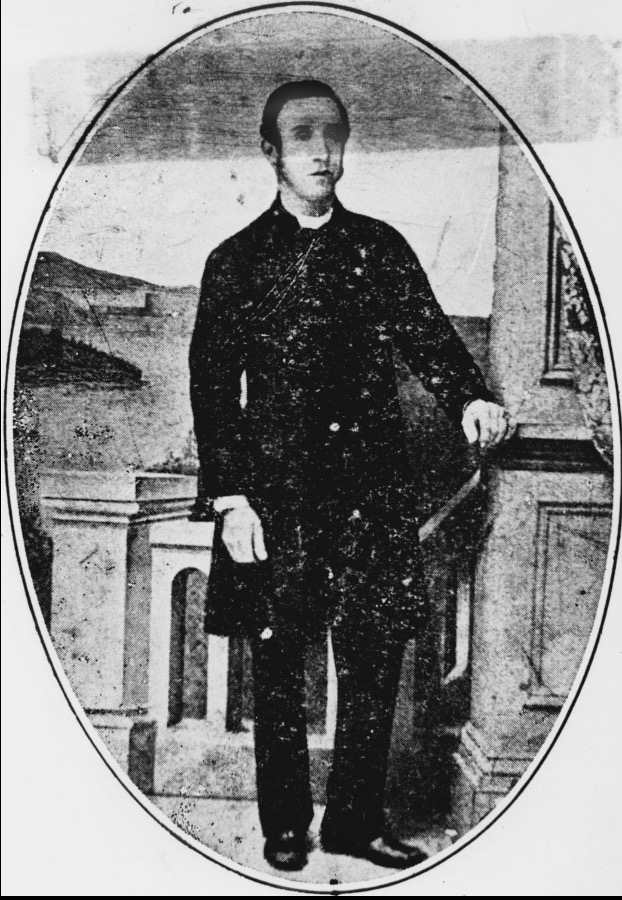
ABOVE: The Reverend Thomas Jones of Rockhampton, as he looked in the 1870s. State Library of Queensland Image No. 21220108200002061.
He laid the foundation of what was now the Diocese and chose the site of the Cathedral and its buildings so wisely, that it never had to be altered. (Applause.)
“HIS HEART WAS IN THE BUSH.”
Time did not permit of his detailing all the churches Canon Jones had built, especially on the Darling Downs.
His heart was always in the bush, and with the people who would be the least cared for.
Some of these churches which he had founded on the Downs had now been replaced by nobler structures.
What was the secret of these successes?
He was not a businessman in the commercial sense of the word, yet he succeeded in his work and he drew people round him as few other men were privileged to do. (Applause.)
A MAGNETIC PERSONALITY.
Some had spoken of Canon Jones as possessing a magnetic personality, but, said the speaker, that was only a term, and not a description of the real force at work.
The first thing was the intense reverence which Canon Jones manifested towards holy things.
It was visible to all, as the sacred writer had said of the High Priest of old; when he went up to the High Altar, he showed the perfection of glory and made everything around him beautiful.
That reverence was based upon his intense faith in the unseen, and in God, which was so real that it could not help indicating itself to the beholders.
HIS GREAT COURTESY.
The next thing was Canon Jones’s extraordinary courtesy.
He would give but one example.
On one occasion he (the speaker) had seen him take off his hat to a girl behind the counter with whom he had been doing business.
He inquired who she was, and Canon Jones had replied that he did not know her, but he took off his hat to every girl whom he met in business, as well as otherwise, as a mark of honour to the mother of Our Lord. (Applause.)
He was a man who held his own convictions most firmly, and particularly his conviction of faith in God and of his own position as a churchman, yet he was most tolerant of the views of other people considering that they had the same right as he to their religious convictions.
GREAT COURAGE.
A great trait in Canon Jones’s character was his courage. No difficulty daunted him.
When other men would have retired into ease, he remained loyal to the Church and devoted to her interests.
In concluding, Canon Garland said it was to honour such a memory they were there that afternoon and no more fitting memorial could be provided than one by which in “handing on the torch” to the young generation of future Queenslanders they held up before them those ideals of reverence based upon faith; of courtesy, tolerance, and courage, which he, whose memory they today perpetuated, so well exhibited. (Applause.)
THE ARCHIEPISCOPAL ADDRESS.
Archbishop Sharp said it had given him singular pleasure to lay the foundation stone.
Because of his great affection for the boys of this school, he longed for religion to be a real factor in their lives, and he thought it was more likely to be so if they had their own chapel.
He believed it would be a handsome one, and he hoped it would be dear to them.
He would pray that it would be an abiding and happy memory to them when, in the natural course of things, they had passed out of school life into the life of other work, and possibly of increased temptation for which their school life aimed at preparing them. (Applause.)
“CONDUCE TO THE LOVE OF GOD.”
Addressing the fine body of boys present, his Grace said it was an excellent thing for them to receive a first-rate general education, as they did there.
It was a fine thing to be trained in ways of manliness and good sportsmanship.
But finer than all was it to believe, in and to love God, who was the Divine Father, the Divine Saviour, the Divine Comforter, who made, them, who cared for them, and who sustained them in life from moment to moment, and who would be their judge; and lest they should think that harsh — who would be the lover of their souls whilst he was their judge.
It was and would be his earnest hope that their chapel and the services they would attend in it, might conduce to this love for and belief in God, for nothing else really mattered.
It was the end and crown of everything.
Rightly did the authorities of this school decide to build a chapel, a house of God, before going on with the building of more classrooms, and the providing of more accommodation.
Let first things come always first. (Applause.)
MEMORIAL TO A REVERED PRIEST.
It was to him an added pleasure and a great honour to have laid the foundation stone of a chapel built specially as a memorial to that revered priest of God, to whom the Church in Queensland would always owe so vast a debt of gratitude, whom it would be impertinent of him to praise.
It was an especial happiness and honour to have performed that ceremony in the presence of the wife and members of the family of the late Canon Jones. (Applause.)
APPEAL FOR OFFERINGS.
He would now turn to what some might consider more practical things.
The money for the building and furnishing of this chapel had by no means been all raised yet.
It would be to their shame if to the debt on this Boys’ Church School of theirs in this city of Brisbane there was added a debt on their chapel, built to honour the memory of such a man as they were trying to honour that day.
Therefore, without any hesitation or shrinking, be appealed for generous offerings to be laid on the Stone, or to be sent in after as a result of that day’s appeal and work. (Applause.)
“SEND YOUR SONS TO THE SCHOOL.”
There was another practical thing he would say.
He was glad that many were gathered together there who would see with their own eyes this school, with its healthy and hygienic buildings and classrooms, and its beautiful and extensive grounds and playing fields.
It was up to the church people of this State to send their sons to it as boarders, and it was up to the church people of this city to send their sons to it as day boys. (Applause.)
In it they would receive an education and a training in manly sport which he believed to be second to none.
His words, as he spoke them, reached only those who heard him; but, perhaps the Press, so uniformly kind to him in reporting what he said, would be the means of their reaching a much wider circle. (Applause.)
FORMING THE MANHOOD OF THE STATE.
He prayed that God would bless and prosper this their undertaking, and that the Church of England Grammar School, Brisbane, might be more and more the means of forming the manhood of their beautiful State, and of fostering true religion in it. (Applause.)
THE CEREMONY.
The Archbishop, then laid the stone, saying: “In the faith of Christ, and with prayer for the blessing of God, I lay this Foundation Stone of the chapel of the Church of England Grammar School, Brisbane, in the name of the Father, and of the Son, and of the Holy Ghost. Amen.”
Offerings were collected while those present sang that grand old hymn, “Now Thank We All in God”.
The offering, which amounted to more than £320, was placed on the stone.
The proceedings closed with the Archiepiscopal blessing.
— from Page 8 of “The Brisbane Courier” of 2 August 1923.
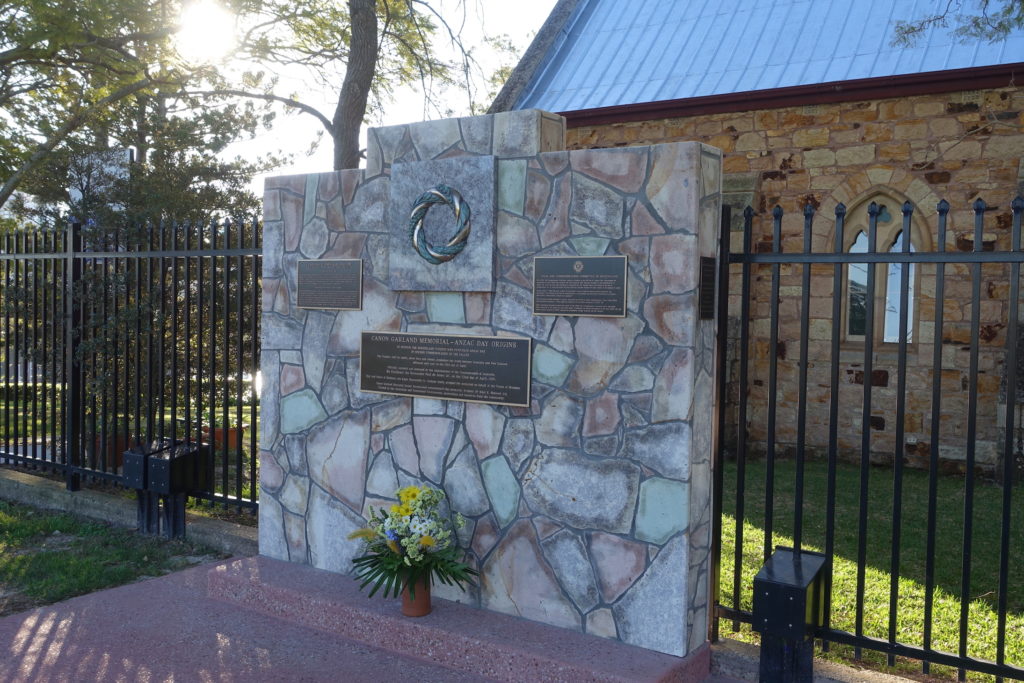
ABOVE: The winter sun sets over the should of Canon Garland Memorial — ANZAC Day Origins, nestled beside historic St Mary’s Anglican Church, Kangaroo Point, Brisbane. Photo courtesy of Peter Collins.
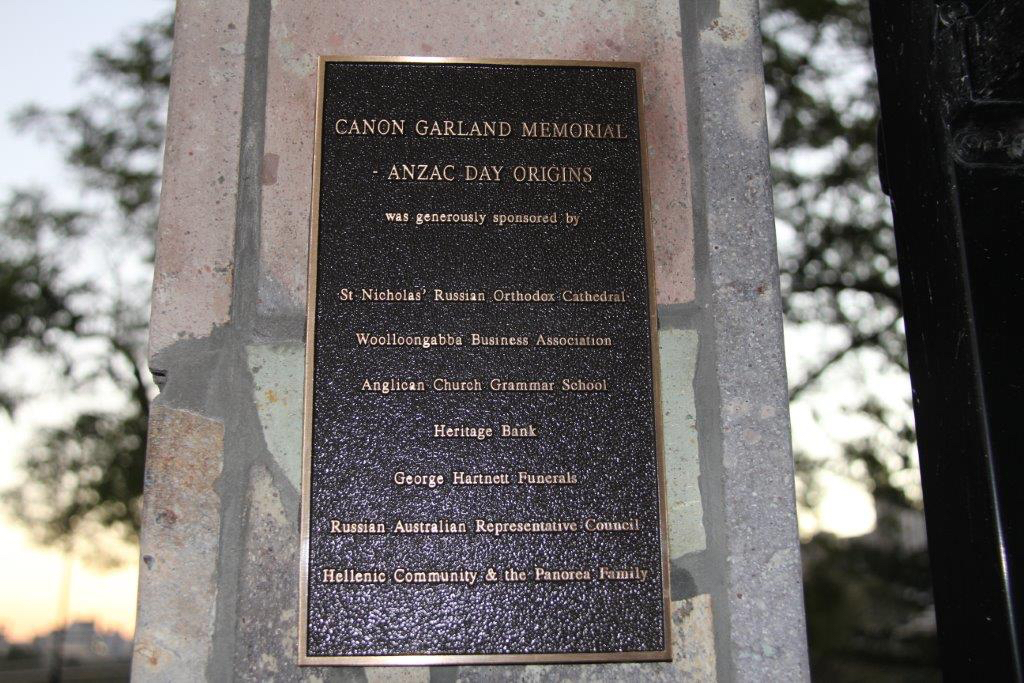
ABOVE: The Anglican Church Grammar School saw fit to donate towards the creation of Canon Garland Memorial — ANZAC Day Origins. This plaque, on the side of the monument, acknowledges the heritage shared between “Churchie’s” origins and the life and works of the Reverend Canon David John Garland OBE VD. Photo courtesy of Peter Collins.
